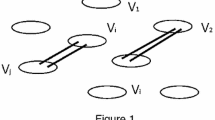Abstract
A set S of positive integers is avoidable if there exists a partition of the positive integers into two disjoint sets such that no two distinct integers from the same set sum to an element of S. Much previous work has focused on proving the avoidability of very special sets of integers. We vastly broaden the class of avoidable sets by establishing a previously unnoticed connection with the elementary theory of continued fractions.
Similar content being viewed by others
References
K. Alladi, P. Erd¨os, and V.E. Hoggatt, Jr., "On additive partitions of integers," Discrete Math. 23 (1978), 201-211.
S. Beatty, "Problem 3173," Amer.Math.Monthly 33 (1926), 159; solution, Ibid. 34 (1927), 159.
T. Chow, "A new characterization of the Fibonacci-free partition," Fibonacci Quart. 29 (1991), 174-180.
R.J. Evans, "On additive partitions of sets of positive integers," Discrete Math. 36 (1981), 239-245.
D.J. Grabiner, "Continued fractions and unique additive partitions," Ramanujan Journal. 3 (1999), 73-81.
V.E. Hoggatt, Jr., "Additive partitions of the positive integers," Fibonacci Quart. 18 (1980), 220-226.
V.E. Hoggatt, Jr. and M. Bicknell-Johnson, "Additive partitions of the positive integers and generalized Fibonacci representations," Fibonacci Quart. 22 (1984), 2-21.
A.I. Khinchin, Continued Fractions, 3rd edition, University of Chicago Press, Chicago, 1964.
I. Niven, H.S. Zuckerman, and H.L. Montgomery, An Introduction to the Theory of Numbers, 5th edition, Wiley, New York, 1991.
A. S´ark¨ozy, "Finite addition theorems, I," J.Num.Theory 32 (1989), 114-130.
Z. Shan and P.-T. Zhu,"On.a; b; k/-partitions of positive integers,"Southeast Asian Bull.Math. 17 (1993), 51-58.
D.L. Silverman,"The Fibonacci split,"problem 567,"Problems and conjectures,"J.Rec.Math. 9 (1976-77), 298.
P.-T. Zhu and Z. Shan,"On.a; b; k/-additive partition of the set of natural numbers,"Sichuan Univ.J.Natural Sci. 26 (1989), 140-144, special issue.
Author information
Authors and Affiliations
Rights and permissions
About this article
Cite this article
Chow, T.Y., Long, C.D. Additive Partitions and Continued Fractions. The Ramanujan Journal 3, 55–72 (1999). https://doi.org/10.1023/A:1009813309003
Issue Date:
DOI: https://doi.org/10.1023/A:1009813309003




